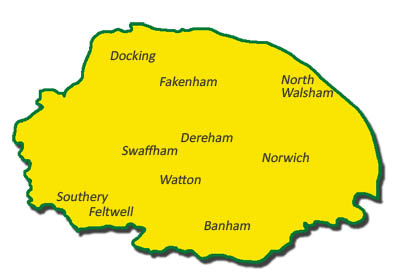Norfolk
Map of the Norfolk Area

County Council
- Norfolk County Council
- County Hall Martineau Lane Norwich Norfolk NR1 2DH
- http://www.norfolk.gov.uk/
Norfolk
Norfolk is a predominantly rural county located on the English east coast. The county's north and eastern borders extend into the North Sea. At Norfolk's northern border with Lincolnshire, a large estuary called The Wash forms a bay at the confluence of five rivers that run through both counties. Norfolk also shares a southwest border with Cambridgeshire and a southern border with Suffolk.
At 5,371 square kilometres (2,074 square miles), Norfolk is one of England's largest and most populous counties. Over eight hundred fifty thousand residents call Norfolk home, however despite its large population the county has a very low population density of only one hundred fifty-five people per square kilometre. Sixty percent of the county's residents live in rural areas. The largest population centre, and only city in Norfolk, is Norwich with a population of two hundred thirteen thousand. The next largest communities in Norfolk are Great Yarmouth with sixty-three thousand residents and King's Lynn with a population of forty-six thousand people. In ancient times, Norfolk was home to the Iceni. Archaeologists have unearthed camps with evidence that flint was quarried in western Norfolk. Romans conquered the Iceni in 60 A.D. and quickly settled Norfolk, developing farmland and constructing ports and roads throughout the county.
Norfolk's medieval history is heavily influenced by its maritime geography. From the fifth to ninth centuries, Norfolk was the subject of repeated attacks from the Angles, Saxons and Danes. These conquerors settled Norfolk and converted the marshy wetlands into farms. Agriculture continued to be Norfolk's leading economic sector after the Norman Conquest. By the late Middle Ages Norfolk had become a major contributor to England's wool and textile industry. (source:http://www.norfolk.gov.uk/index.htm)
Food and farming continue to be important to Norfolk's economic development. Following World War Two, production of cereals, rapeseed oil and beets increased as more arable land came available through drainage and land development projects.
Norfolk has a well-developed tourism industry. Visitors are attracted by the large number of seaside resorts, national parks and bird sanctuaries. The Queen also maintains a residence, Sandringham House, which attracts tourists in all seasons. Many Londoners choose Norfolk as the site for their holiday homes. (source: http://www.visitnorfolk.co.uk/)
Transport
- North Norfolk Community Transport
- http://www.northnorfolkcommunitytransport.co.uk/
- Banks and Building Societies
- Branch finder for all Norfolk high street banks listing the address, telephone number, facilities and opening times for each. Also offers savings and investment information, tips and comparisons.
- http://www.theinvestingsite.com/banks/norfolk
Media
- North Norfolk News
- http://www.northnorfolknews.co.uk/
- Norwich Evening News
- http://www.eveningnews24.co.uk/
Tourism - Official Site
- Visit Norfolk
- The Grove Kenninghall Road Banham Norfolk NR16 2HE
- Phone: 0333 320 4202
- http://www.visitnorfolk.co.uk/
Museum
- Norfolk Museum and Archaeology Service
- NMAS Shirehall Market Avenue Norwich NR1 3JQ
- http://www.museums.norfolk.gov.uk/
University
- University of East Anglia
- Norwich Research Park Norwich NR4 7TJ UK
- http://www.uea.ac.uk/
